May 15, 2025 | 12:46 GMT +7
May 15, 2025 | 12:46 GMT +7
Hotline: 0913.378.918
May 15, 2025 | 12:46 GMT +7
Hotline: 0913.378.918

Dong Nai forest rangers inspect wildlife breeding facilities. Photo: ILRI.
Over 10 years ago, when the idea of strengthening the partnership between the agriculture and health sectors on public health issues first emerged, Dr. Phan Van Phuc, Head of the Infectious Disease Control Department at the Dong Nai Center for Disease Control (CDC), recalls it as if it were just yesterday.
At that time, Dong Nai province was a national leader in intensive livestock farming, including the farming of wild animals. All preparations were in place. Most wild animal farming facilities had been issued breeding registration certificates. However, the issuance of these certificates only confirmed the origin of the animals as per regulations without proving whether the animals had been quarantined. This created challenges for trading these products in the market and posed potential risks of disease transmission, including to humans.
"About two-thirds of infectious diseases in humans originate from animals," Dr. Phuc explained, adding that CDC staff like him have always been concerned with detecting emerging and dangerous animal diseases early to reduce the risk of transmission to humans.
With the belief that protecting public health is a societal responsibility, Dr. Phuc and his colleagues proposed a coordination protocol to strengthen cooperation between the agriculture and health sectors. Starting with dangerous diseases such as rabies and avian influenza, intersectoral working groups in Dong Nai province gradually expanded their focus to prevent diseases transmitted from wild animals.
From three leading agencies - CDC, the Sub-Department of Animal Husbandry and Veterinary, and the Sub-Department of Forest Protection - the parties now regularly exchange information, coordinate investigations, and respond to infectious diseases from animals, ensuring that tasks are clearly and scientifically assigned, which allows for quick and timely responses to disease outbreaks.
This protocol proved particularly effective during a disease outbreak at a civet farm in Dong Nai province, where two-thirds of the animals died.

Le Van Hanh, the farmer in Vinh Tan commune, periodically disinfects barns. Photo: ILRI.
According to Dr. Phuc, if the sectors worked in isolation, the agriculture sector would only focus on controlling animal diseases, while the health sector would concentrate on preventing human transmission. Given the large number of animals and the limited awareness of the farmers, the task took a lot of work to complete in a short time. However, thanks to close coordination, the workload was nearly halved.
"It took us about 20 days in total. After that, the civets' health stabilized, and the farm owner was confident enough to re-stock," Dr. Phuc shared, acknowledging that the intersectoral team did not overlook any potential risks while simultaneously performing both tasks.
The intersectoral coordination protocol No. 6552/QCPH-SYT-SNNPTNT issued on September 30, 2022, opened new avenues for livestock farming in Dong Nai province. In many communes, wards, and townships, locals have witnessed the cooperation between veterinary and local health workers in detecting and controlling diseases, especially the province's eight priority diseases.
From the tentative steps taken in 2012, Dong Nai province has implemented comprehensive solutions, notably establishing a unified legal framework. Plan No. 58/KH-UBND, dated February 23, 2024, on the prevention and control of livestock, poultry, and aquatic diseases, involves the participation of the health sector. Plan No. 136/KH-UBND, dated April 11, 2024, on the prevention and control of infectious diseases, also includes the responsibilities of the agriculture sector.
After two years of implementing Coordination Protocol No. 6552 between the health and agriculture sectors, Dong Nai farmers have felt the benefits.
In Vinh Cuu district, which borders Cat Tien National Park and serves as the northwest gateway of the province, the sale and transport of wild animals was a significant concern for local authorities. These activities directly affected the "traditional" profession of farming bamboo rats and civets. Allowing one disease-carrying intermediary like a tick, fly, or mosquito could have unpredictable consequences.
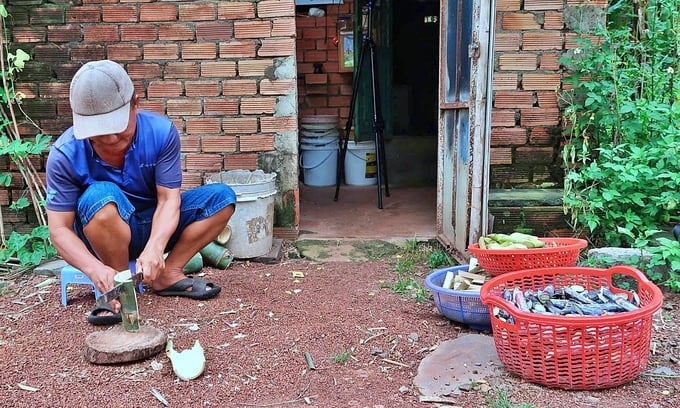
Hanh prepares food for a facility raising about 100 bamboo rats. Photo: ILRI.
However, since Le Van Hanh started farming bamboo rats in 2018, a few years after Dr. Phuc's intersectoral coordination idea was widely implemented, his facility of over 100 animals in Vinh Tan commune has thrived.
"I'm very confident," he said, revealing that the secret lies in being well-versed in animal disease prevention and ensuring measures to prevent transmission to humans. According to him, the facility is cleaned every two days, and he disinfects the entire area monthly.
With a selling price of around VND 2 million (USD 80) per pair of 600-800 gram animals, VND 2.5 million (USD 100) per pair of 800-1,000 gram animals, and VND 700,000 (USD 28) per kilogram for commercial bamboo rats, the business generates an additional income of about VND 100 million (USD 4,000) per year.
Visiting Hanh's facility reveals how valuable the knowledge gained from training sessions is. The cages are stacked nearly to head height in a few dozen square meters. The density is relatively high, but the entire space is clean, well-ventilated, and, most importantly, odor-free, with no environmental pollution.
In his free time, Hanh forages for food for the bamboo rats, typically roots, tubers (bamboo shoots), or plants from the bamboo family, such as bamboo, reed, and sugarcane, as well as elephant grass, vegetables, and fruits. He said that this profession almost only requires effort and is very "easy on the mind." Following forest ranger advice, he does not import bamboo rats of unknown origin. With additional guidance from health and veterinary forces, he no longer worries about disease, even with dense farming.
Nguyen Thi Thiet, a farmer in Phu Ly commune, also raises wild animals. Her civet population has grown to over 30 from an initial stock of five. Despite living 50 kilometers from Vinh An township, Thiet is regularly visited, encouraged, and guided by Vinh Cuu District Forest Protection officers on environmental sanitation and ensuring farmers' and future consumers' safety and health.
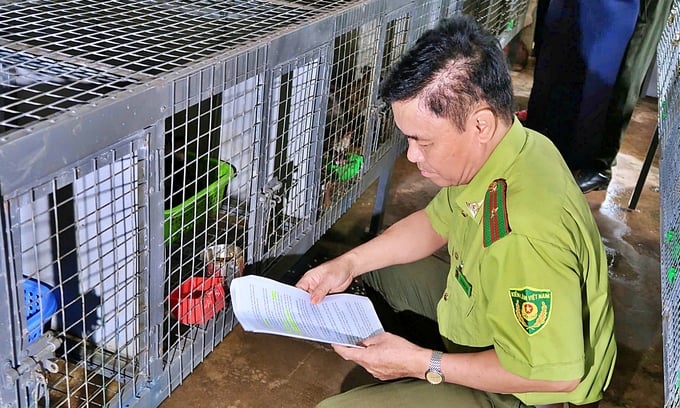
Bui Minh Tan, Sub-Department of Forest Protection, guides farmers in preventing infectious diseases from animals. Photo: ILRI.
Dinh Nam Khuong, a Vinh Cuu District Forest Protection officer, said locals have a tradition of raising wild animals for many years. If they don't declare and register their facilities, the risk of disease outbreaks is not small, especially for emerging diseases.
"We recognize that people raise wild animals in their spare time to increase income. Therefore, most rely primarily on experience. Forest protection officers must constantly visit each facility to guide people on procedures, ensure compliance with legal regulations, and act as a bridge between farms to exchange information about breeding techniques," he explained.
Bui Minh Tan, Deputy Head of the Forest Protection, Conservation, and Legal Department at the Dong Nai Sub-Department of Forest Protection, added that previously, farmers had to receive information from various sources - disease prevention from the veterinary system, registration through forest protection, and health assurance from the health sector.
With the implementation of the coordination protocol, forest protection forces can now guide them all at once. Besides disseminating and guiding registration procedures, forest protection officers also check and supervise farmers' breeding plans, including infrastructure, area, density appropriate to the species, farming technology, capacity for feed supply, disease prevention, and environmental sanitation.
"We are determined not to allow the import of wild animals without quarantine certificates. We also coordinate sampling from breeding facilities and investigating and handling outbreaks when issues arise," Tan shared.
The practical experience in Dong Nai province aligns with the goals of the CGIAR One Health initiative.
Dr. Fred Unger, Regional Representative for the International Livestock Research Institute (ILRI) in Asia, stated that for a long time, scientists worldwide have agreed that human health, animal health, and environmental health are closely interconnected. Based on this, health experts, veterinary experts, and experts from health and environmental sectors tend to interact rather than work in isolation.
"The approach in Dong Nai province is a vivid example that 'One Health' is not just theoretical. Together, everyone takes part responsibly to ensure that all constituent elements are healthy," Unger commented.
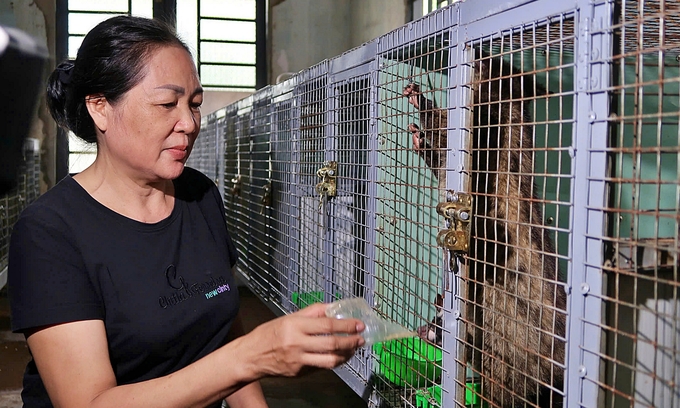
Nguyen Thi Thiet, the farmer in Phu Ly commune, is feeding ferrets.. Photo: ILRI.
Agreeing with this, Nguyen Truong Giang, Head of the Dong Nai Sub-Department of Animal Husbandry and Veterinary, said that farmers in the province, besides reporting their herds, must also consider environmental factors and ensure they do not affect the landscape.
Farming facilities, especially those raising wild animals, must pass disease safety inspections before selling products. Facilities that do not meet requirements will be inspected and monitored and may even be relocated.
The Sub-Department also advises the Department of Agriculture and Rural Development and the Provincial People's Committee to promote the One Health approach and implement biosafety interventions at household-scale farms to eliminate the root cause of disease outbreaks. The farmers choose the measures that help them change their perception of using protective gear and reduce the risk of pathogen transmission.
"The intersectoral coordination protocol has connected the veterinary, forest protection, health sectors, and local governments in proactively preventing, detecting, and coordinating responses when diseases and outbreaks occur at breeding facilities. We aim to eliminate administrative procedures, requiring only phone notifications, which speeds up response times when issues arise," Giang emphasized.
Translated by Huong Giang

(VAN) Data from 10,000 farming households will help professionalize production organization and support the implementation of the One Million Hectares Program for High-Quality, Low-Emission Rice Cultivation.

(VAN) FAO Director-General QU Dongyu marks International Day of Plant Health at NENA conference.

(VAN) Deputy Minister of Agriculture and Environment Hoang Trung affirmed that floriculture and ornamental plants are a growing industry that receives significant global attention.

(VAN) The three staple crops dominating modern diets – corn, rice and wheat – are familiar to Americans. However, fourth place is held by a dark horse: cassava.
/2025/05/10/4037-3-223011_495.jpg)
(VAN) Remote sensing technology is becoming an indispensable tool in monitoring resources, developing modern agriculture, and protecting the environment in Vietnam.
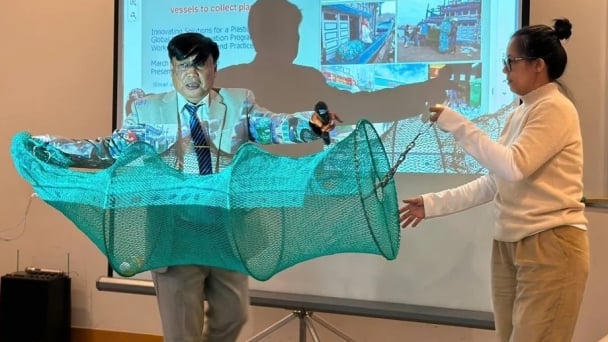
(VAN) The trash bag used on fishing vessels can withstand rough sea conditions, including level 8 to level 10 winds and waves. Notably, it can be hung anywhere on the boat.
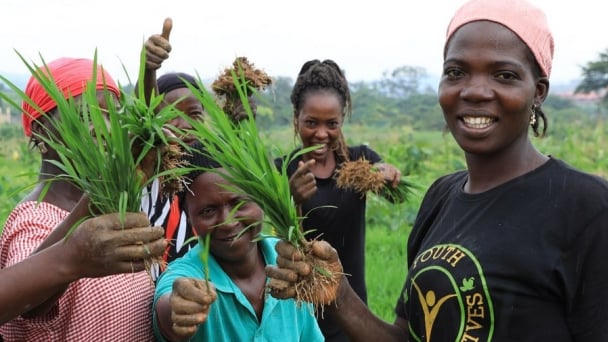
(VAN) African leaders launched the Kampala Declaration on Building Resilient and Sustainable Agrifood Systems in Africa, marking a bold step toward transforming the continent's agriculture.